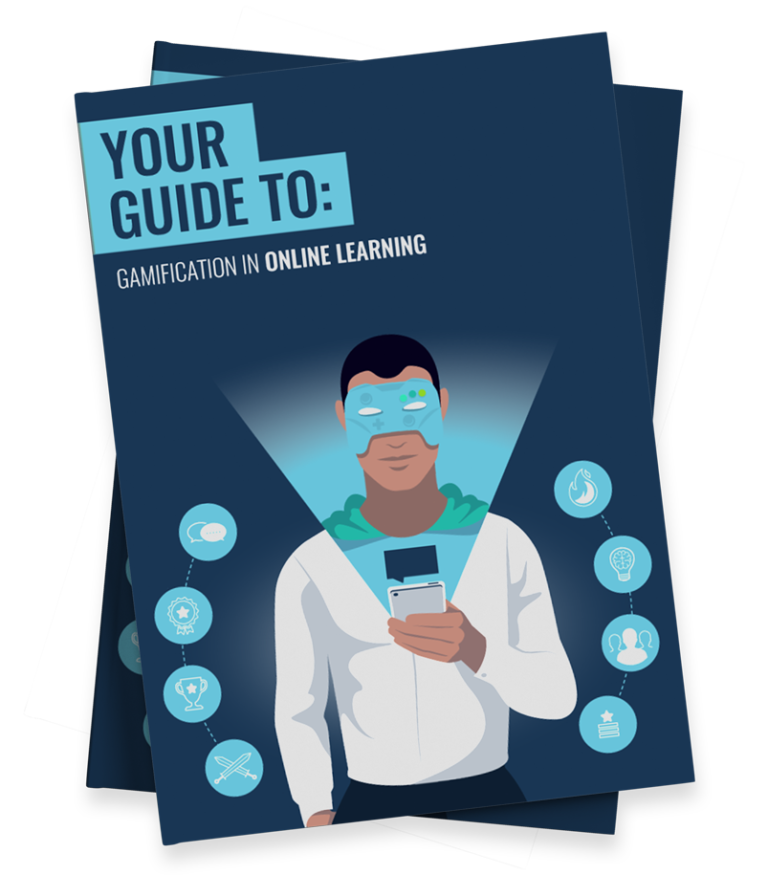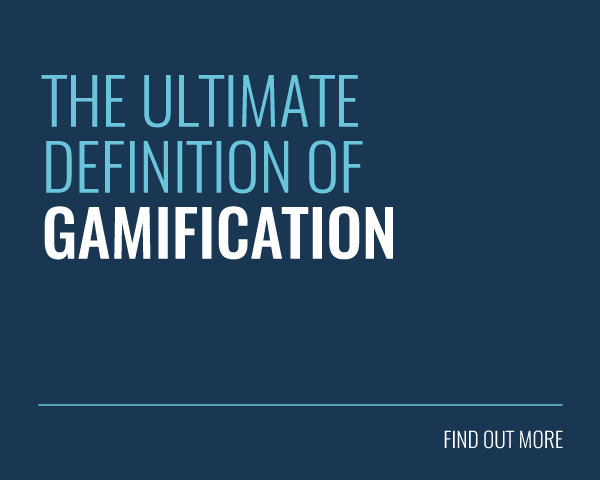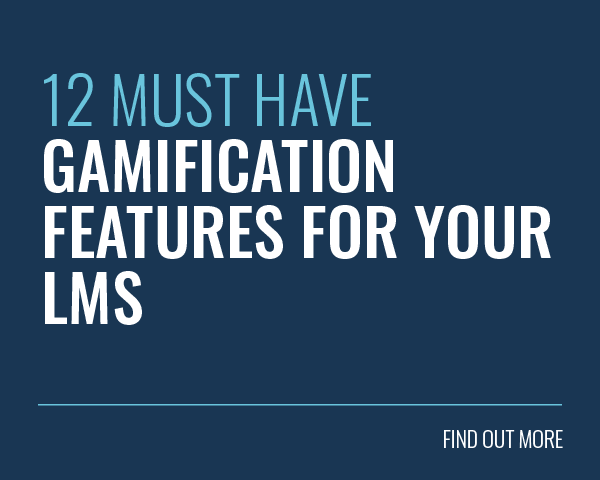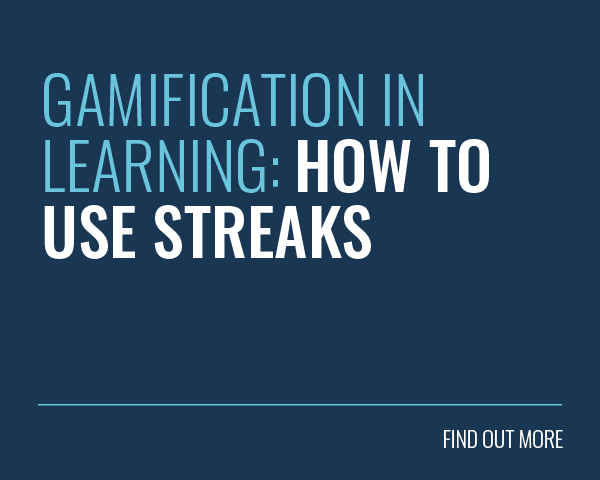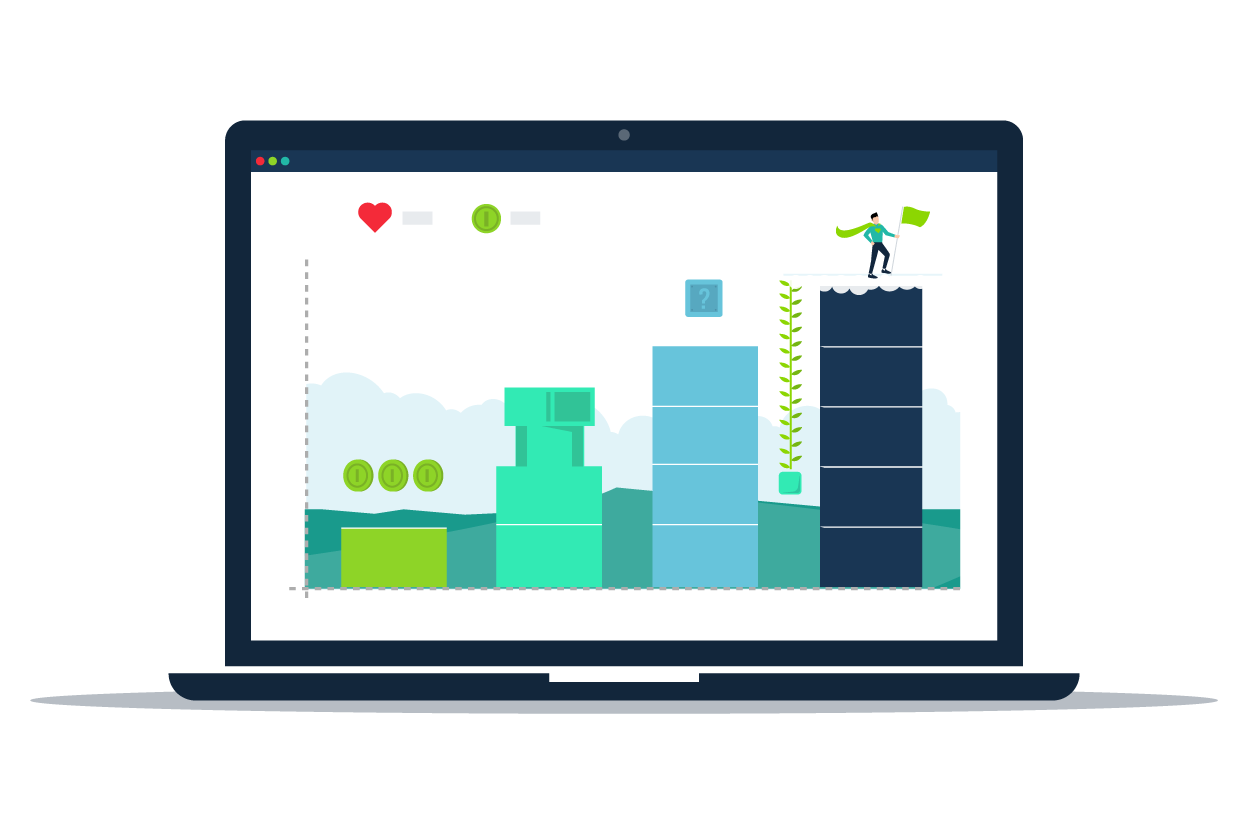 Gamification is no longer a buzzword. Since the term was first coined in 2003, it has continued to grow in prominence. In fact, if you examine the hard data, it suggests that gamification trends has now crossed over into the mainstream.
Gamification is no longer a buzzword. Since the term was first coined in 2003, it has continued to grow in prominence. In fact, if you examine the hard data, it suggests that gamification trends has now crossed over into the mainstream.
But first of all, what is gamification? Gamification is the application of game-inspired design and mechanics into a non-gaming environment. It’s purpose is to increase motivation and engagement levels for users, to drive behaviour change and achieve specific goals.
Today, companies worldwide are now using it to great effect to enhance user engagement and productivity.
In fact, 85% of employees are shown to be more engaged when gamification solutions are applied to their workplace.
Furthermore, as gamification-focused learning technology experts, we are delighted to see that 90% of survey respondents believe that gamified learning solutions are effective. There are also many examples of businesses who have gamified their processes, and have seen impressive results.
But as the world continues to change, how will gamification evolve to fit the changing needs of today’s modern learners? Has gamification reached its pinnacle? How can you apply these trends to design better gamified programmes?
Previously, we explored the current L&D trends, but now it’s time to focus solely on gamification. In this article, we have carefully rounded up the key trends that will affect the gamification space in the next five years. So if you’re ready, let’s dive in!
Market Trends
1. The Global Gamification Market Will Continue to Grow
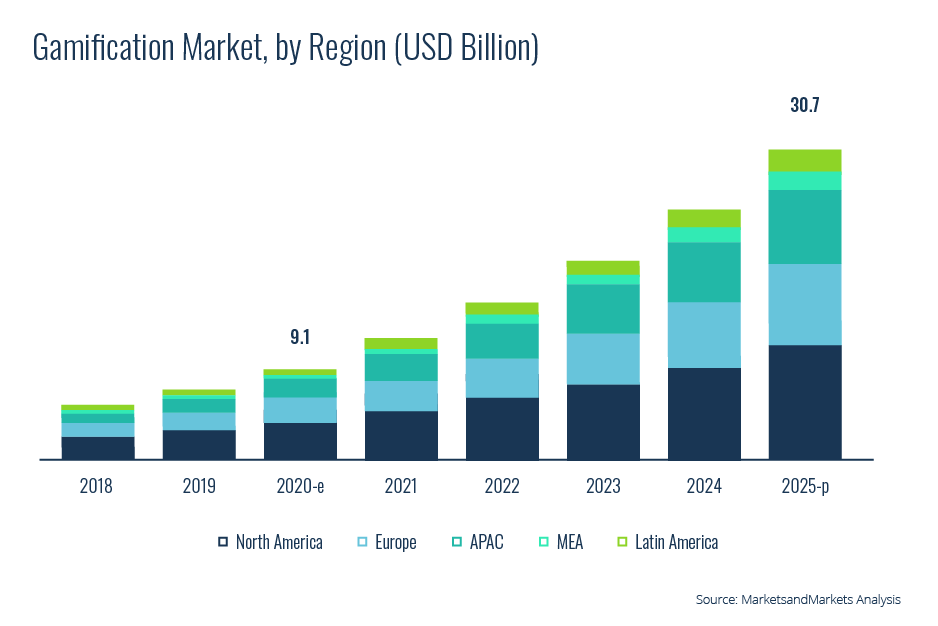
The world will continue to see an increasing demand for gamified systems.
In fact, the global gamification market is projected to grow from $9.1 billion in 2020 to $30.7 billion by 2025, at a compound annual growth rate (CAGR) of 27.4%.
North America will continue to account for the largest share of the global gamification market for the next five years. This will be driven by the region’s dominant number of mobile internet users, with 90% of residents owning a smartphone.
The gamification market in Europe will also develop significantly within the forecasted period. The support of local governments and key stakeholders will help to bolster this growth. For instance, policymakers in the United Kingdom and France will host more gamification conferences and events.
While North America and Europe will remain the largest players, other regions are catching up.
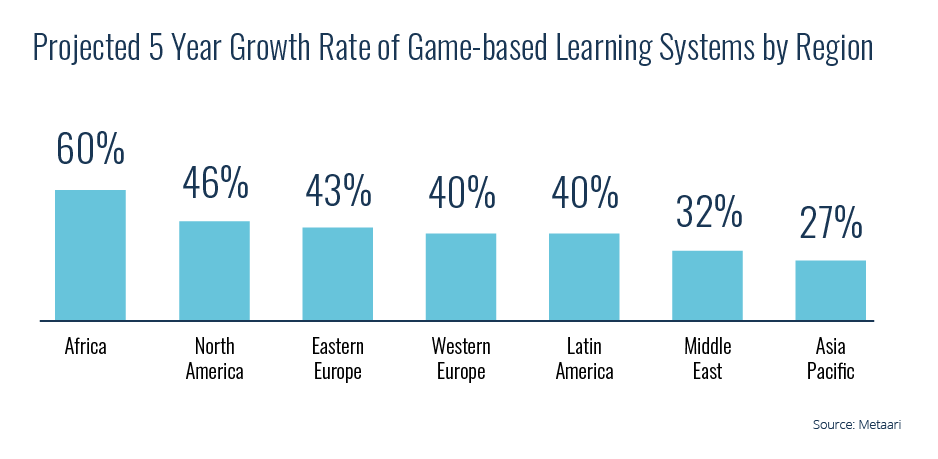
Africa shall see the fastest growth rate, with gamification in the region forecasted to expand by 60.1% by 2023. A large part of this rise will stem from the increase in local and regional providers of gamified solutions.
Similarly, Latin America and the Middle East will flourish, as more startups adapt to gamified solutions in the continent. The rise of eLearning and game-based education in Brazil will also help boost gamification in the region.
Asia Pacific will also grow exponentially. China and India will help drive the gamification market in the region as they focus on enhancing the user experience.
2. Large Enterprises Will Dominate the Business Sector
A Gartner report shows that gamification has now been adopted by more than 70% of businesses belonging to the Global 2000 list of companies. This trend will continue to grow as more organisations gamify their business operations.
Large enterprises are expected to hold the largest market share, with many of them having been early adopters of the software. They are also likely to invest in more innovative gamified solutions. Companies such as Oracle, Hewlett Packard, IBM, and Google will help drive this trend.
Small businesses will also gamify their recruiting and sales activities in response to increasing competition in the SME space. We also anticipate that this sector will ramp up their use of gamification strategies through the use of social media.
3. The Retail & Education Sectors Will Approach Maturity
Gamification is approaching maturity in the education and enterprise retail sectors. To date, retail is the top adopter of gamified solutions, holding a 28.6% market share. Education follows closely as the next most popular sector.
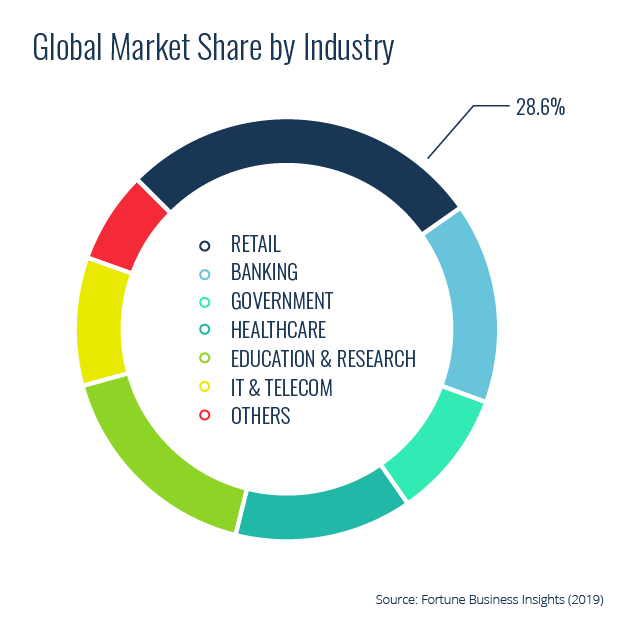
This comes as no surprise as 80% of learners are more effective with gamified practices. Moreover, with a whopping 97% of kids playing computer games, teachers will continue to gamify their classroom practices.
On the retail side, organisations are benefitting from gamified training practices. Gamification has been shown to improve employee engagement by over 60%.
Perhaps this is why 87% of businesses are projected to utilise gamified techniques in the next five years. Half of these companies will also consider gamification as a top priority.
One good example would be L’Oréal’s gamified solution for its travel division, L’Oréal Travel Retail. They wanted a better solution to train their Beauty Advisors (BAs) based in various regions across Asia-Pacific. In partnership with Growth Engineering, they created a gamified mobile app to train and engage their learners. As a result, the company surpassed engagement and customer satisfaction goals within a year of deployment.
To date, L’Oréal Travel Retail continues to develop and roll out new gamified features for their global community of BAs.
4. Gamification Will Expand to More Sectors
Gamification will continue to grow in popularity across a variety of industries. These include IT, banking, the public sector and even the military.
Notably, the continued boom of the IT sector over the next few years will drive the expansion of gamification throughout the industry. For instance, IT companies will gamify large-scale recruiting activities to streamline job applications. Recruiters will gamify virtual screenings and assessment tests, to filter out and select candidates.
We will also continue to see gamification’s impact in the military sector.
The United States Army for example, launched a gamified platform to support its recruitment activities. Specifically, enrollees are able to put their skills to the test, and see if they have what it takes to be a soldier.
While virtual battles cannot replace real world combat, it proved to be a cost-effective tool in attracting more recruits. In fact, this has driven 30% of Americans (aged 16-24 years old) to have a more positive impression of the US army at a fraction of the recruitment cost.
Workplace Trends
5. Gamification Will Drive Recruitment & Training Programmes
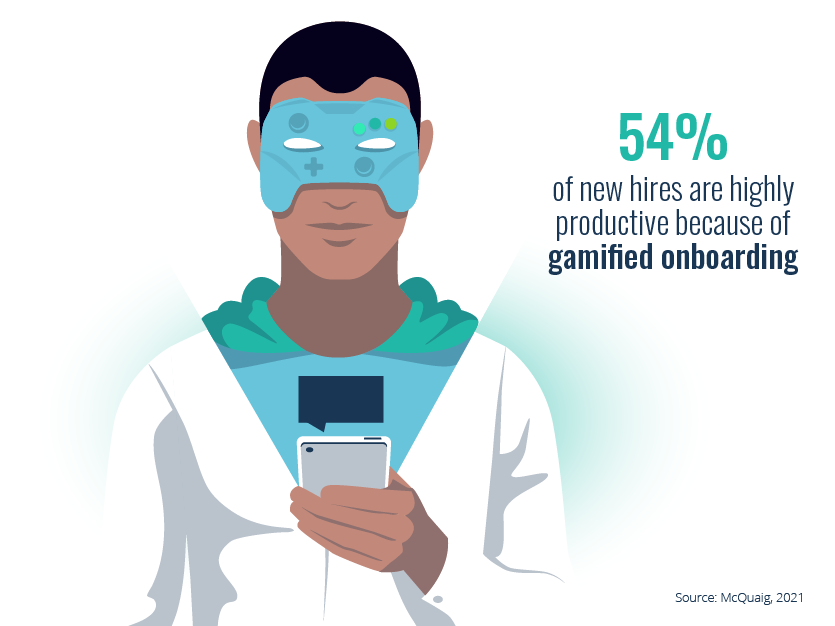 The COVID-19 pandemic has created the need for companies to shift to fully online recruitment and training solutions. It has become increasingly necessary to create flexible and engaging L&D programmes for remote teams. As such, organisations will continue to employ gamified solutions to address these challenges.
The COVID-19 pandemic has created the need for companies to shift to fully online recruitment and training solutions. It has become increasingly necessary to create flexible and engaging L&D programmes for remote teams. As such, organisations will continue to employ gamified solutions to address these challenges.
Gamified eLearning modules are helping employees to understand new processes and ways of working.Teams are also receiving real-time feedback on their learning progress thanks to game components like levels and scorecards.
As such, the results speak for themselves. Over 54% of new hires report being highly productive after undergoing a gamified training programme. Participants are also found to score 14 points higher in skill assessment tests compared to others.
One good example would be the case of Domino’s Pizza, one of the world’s most popular pizza chains. In 2015, the company gamified its recruitment and upskilling processes by launching Pizza Hero.
This is a mobile app packed with gamified elements such as a leaderboard and rewards. The initiative proved to be a roaring success. The release of the app increased sales by as much as 30%.
6. Key Benefits Will Be Employee Engagement & Productivity
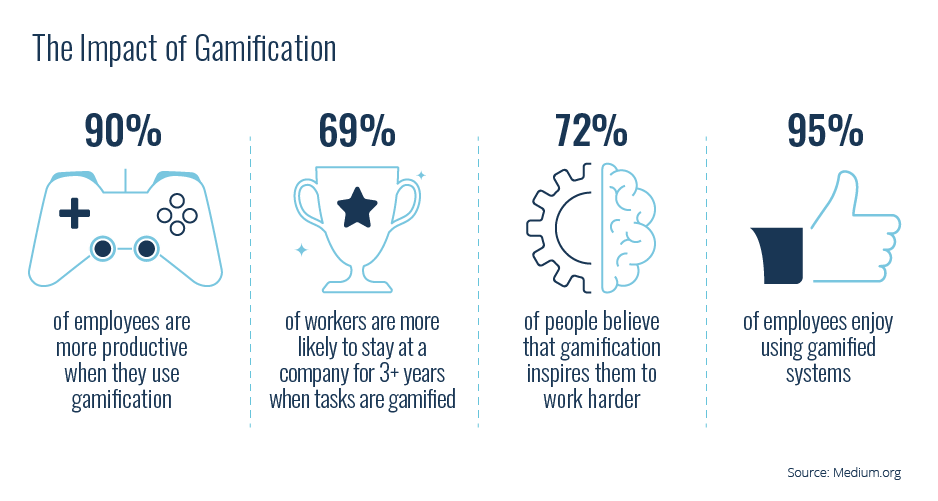
Employee engagement will remain to be one of the top challenges facing managers today and for the foreseeable future. To address this, companies are turning to gamification to make work more meaningful and fun for their employees.
Studies show that these gamified initiatives have increased workplace engagement by 48%. What’s more, 72% of workers report feeling motivated to work harder. In a similar vein, gamification has been demonstrated to boost employee productivity by 90%.
One example of this increased productivity comes from FreshDesk. They provide a cloud-based help desk platform, managing over 40,000 clients. In 2012, FreshDesk employed gamification to engage their customer reps with their day-to-day tasks. In turn, this has increased team productivity, leading to an astonishing 1,000% increase in revenue within the first year of launch.
7. Gamification Will Support Human-Centered Design
 Studies show the growing importance of human-centered design to support the needs of modern workers. Similarly, empathetic managers are what drives 92% of employees to remain in their jobs.
Studies show the growing importance of human-centered design to support the needs of modern workers. Similarly, empathetic managers are what drives 92% of employees to remain in their jobs.
As such, employee feedback is now driving the design of gamification strategies. Companies are now aligning bigger organisational objectives with their workers’ values. For instance, gamified initiatives are increasingly shaped around an employee’s sense of epic meaning.
The Octalysis Framework will remain a useful tool for designing gamified training programmes. This framework shows the benefits of extrinsic vs. intrinsic motivators. It also explains the limitations of different types of incentives.
For instance, it shows how extrinsic rewards may fall short in driving long-term behaviours. Intrinsic incentives, on the other hand, may fail to instill a sense of urgency among learners.
Overall, this framework will continue to guide organisations towards implementing human-centered strategies.
8. More Marketing & Sales Activities Will Be Gamified
Today’s companies are gamifying their marketing activities to drive customer acquisition and retention goals. They are using gamification to engage users across all points of the customer journey. In fact, 93% of marketers love gamification and will continue to implement it in their campaigns.
Myntra, an Indian fashion e-commerce site, is one successful example. Back in 2019, the company gamified their app, to boost brand awareness and sales for their End of Reason Sale campaign. The app enables users to play games in exchange for points and rewards.
It also provides information and education about current fashion trends in the market. As a result, this has enticed customers and has driven significant traffic to the app. Within the campaign’s duration, over 650,000 users have engaged with the platform. This year, they will continue to use gamified mega marketing campaigns to reach 250 million more customers.
The global retail industry is predicted to grow at a tremendous pace, thanks to a surge in e-commerce activity. As such, we can expect more companies to enrich their online digital activities with the help of gamification.
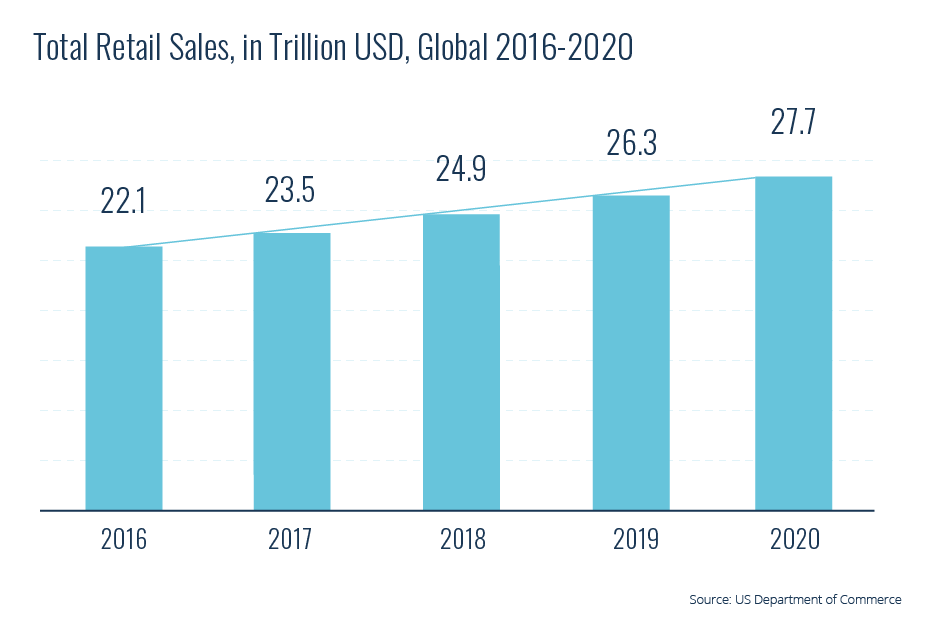
9. Gamification Will Provide More Robust Data & Insights
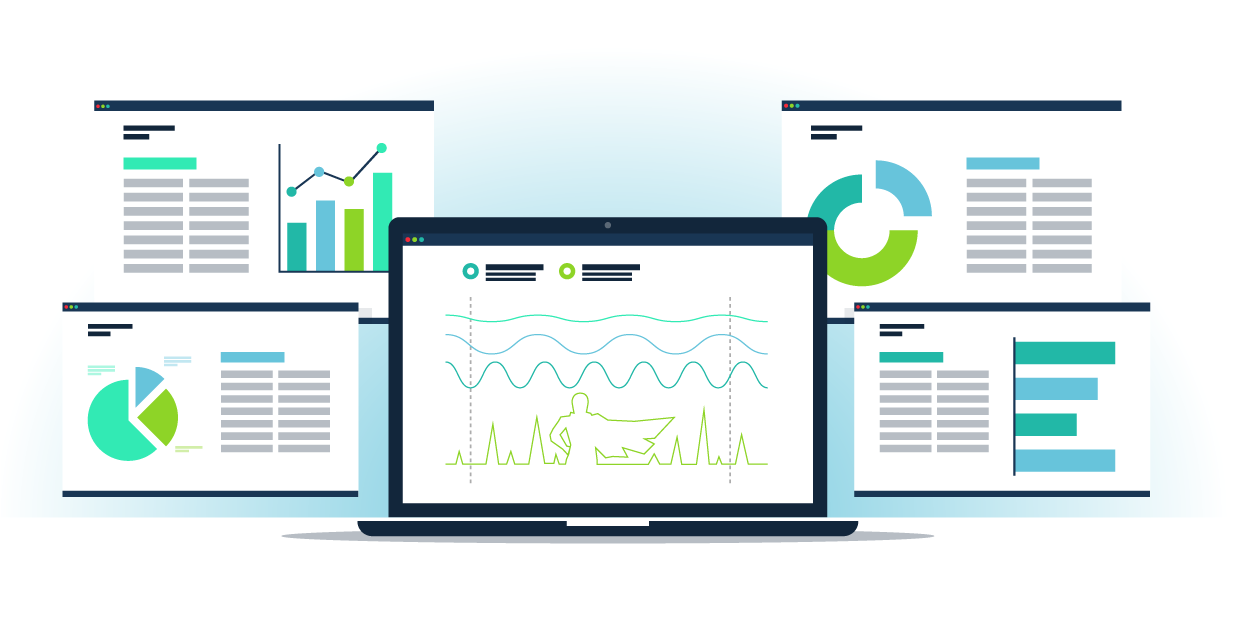 One of the key benefits of gamified online training software is its ability to provide real-time and actionable data. This means that companies are able to track the progress of their employees at any point of their training programme. This then allows managers to immediately make any adjustments needed for their learners.
One of the key benefits of gamified online training software is its ability to provide real-time and actionable data. This means that companies are able to track the progress of their employees at any point of their training programme. This then allows managers to immediately make any adjustments needed for their learners.
Similarly, marketers are gleaning valuable customer insights from data enabled by their gamified platform. This helps them better understand consumer behaviour and preferences.
Gamification analytics is also supporting product innovation. An example would be Dunkin’ Donuts, one of the world’s largest doughnut chains. The company created an online game called On Your Mark, to help collect customer insights. The platform invited customers to engage in online challenges, in exchange for Dunkin’ Donuts gift cards. This enabled the company to collect players’ data and valuable consumer insights.
What’s more, gamification is helping support the data collection process itself. For example, scientists at Scripps Research Institute have gamified their research method. They created Dizeez, an interactive online quiz for their scientists. This gamifies the process of cataloging gene disease associations. In turn, this has attracted more contributors. As a result, scientists have been able to pool their expertise and form new data connections to examine.
Social Trends
10. Gamification Will Be Popular With Millennial Workers
 Today, millennials account for 35% of our global workforce. By 2025, they will account for 75% of the global population. This equates to more than half of the global workforce!
Today, millennials account for 35% of our global workforce. By 2025, they will account for 75% of the global population. This equates to more than half of the global workforce!
However, a report prepared by Gallup currently shows that 71% of millenials feel little or no commitment to their work. Furthermore, a Deloitte study shows that 44% of millennial respondents are stressed most of the time.
As a generation raised on computers and video games, it’s only natural that gamification will help solve these problems. This is why organisations are gamifying their processes to cater to this generation’s distinct workplace needs.
Gamification satisfies millennials’ appetite for collaborative and engaging interactions.
While gamification and social are two separate things — they just happen to work well together. Adding game mechanics to a social environment can help to fuel a community.
One study shows that 88% of millennials find their job fulfilling when provided with opportunities to make a positive impact. As such, companies are combining social incentives with their gamified programmes.
One good example would be Microsoft, the world’s largest software company. A few years back, it gamified its operations to encourage its team members to submit product feedback. The company linked game mechanics with real-world donations to their partner charities. This helped user feedback to increase by 16x.
As such, we can see how gamification will continue to help drive this generation’s desire for purpose in the years to come.
11. Personalization Will Only Get Better
Standardized gamification systems are becoming a thing of the past. In fact, 74% of consumers get frustrated when they receive content that has nothing to do with their interests. 94% of businesses say personalisation is critical to their success.
Personalisation is important for business success, which means it’s also important within gamified solutions. This trend will continue to boost gamification’s appeal for modern learners. Various gamification vendors offer tools to help managers and instructors design personalised gamified experiences for their audience.
For example, Growth Engineering’s gamified learning management system offers customised learning pathways. This feature empowers admins and managers to create personalised learning journeys for their teams. This content sits within a customisable environment that can help to drive further epic meaning.
When it comes to personalisation, we’ve only seen a glimpse of its enormous potential. The best is yet to come. The advances being made in learning technology will soon enable even more ways of personalising a learner’s journey.
12. More Brands Will Gamify Their Social Media Activities
More than half of the world now uses social media. Similarly, the number of social media users who identify as ‘gamers’ has grown by more than 10 million, or 32% in the last year.
Social media triggers the release of the same neurotransmitters that make games so addictive. For instance, dopamine is released each time we discover new information.
Similarly, we get a rush of oxytocin when we engage in positive social interactions. In fact, did you know that regular Facebook users are 43% more likely to trust other people than non-users?
Today, many companies are gamifying their social media initiatives to boost brand engagement and trust. Big businesses such as M&M’S, LinkedIn and Waze have integrated game elements into their social media strategies with great success.
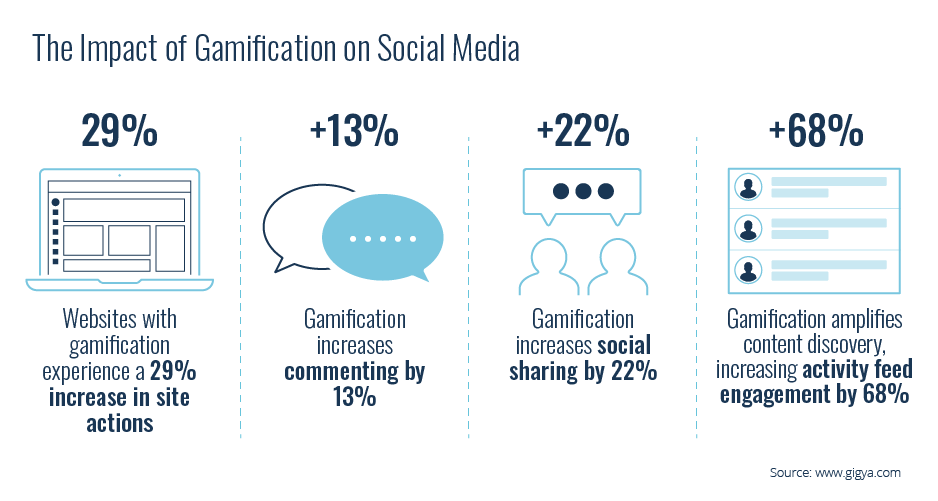
We expect more companies will soon follow suit. After all, social media has been shown to boost engagement metrics by 100-150%.
NextGen gamified learning systems are also offering similar social features such as Clubs and push notifications. Learning administrators and professionals are thus able to tap into the very same motivations that make social media so engaging.
Sustainability Trends
13. Gamification Will Drive Corporate Sustainability Campaigns
Consumer demand for sustainable brands will only increase in the coming years. The pandemic has accelerated this trend. 95% of survey respondents are now more concerned with environmental issues. Today, more than 90% of business leaders consider sustainability to be one of the key drivers for their company’s success.
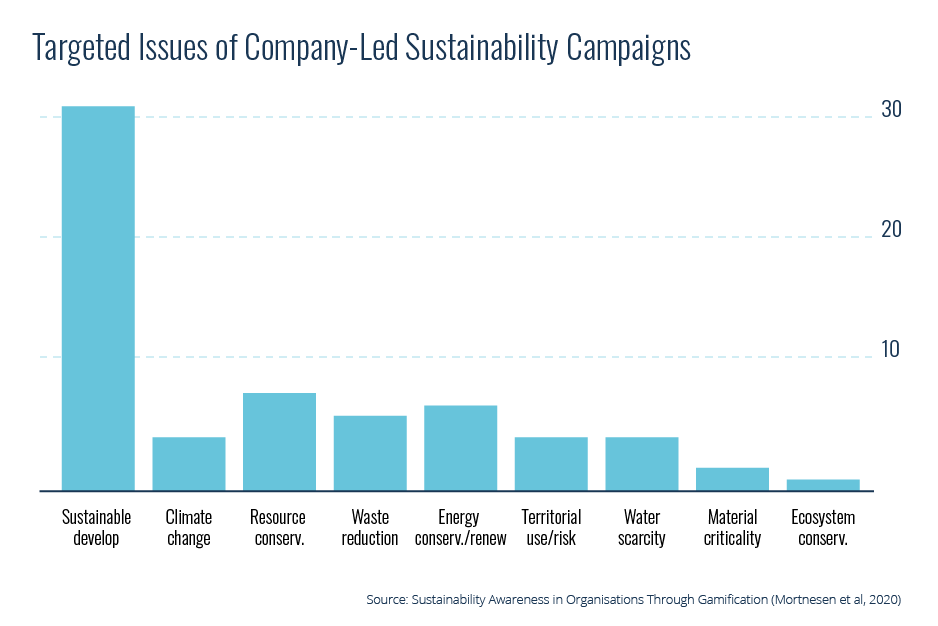 As such, companies are stepping up their sustainability initiatives with the help of gamification.
As such, companies are stepping up their sustainability initiatives with the help of gamification.
Some notable companies have already started gamifying their sustainability campaigns. Toyota, for instance, uses gamification to encourage their customers to become more energy-efficient.
Other organisations have also integrated the gamification of sustainability into their business model. One example is Recylebank, a New York based company on a mission to encourage recycling and good environmental habits. It rewards members for participating in everyday green actions. Users earn Recyclebank Points which they can then exchange for deals and discounts at local businesses.
With the global sustainability market set to grow at a CAGR of 26.6% until 2025, we can only expect more companies to adopt gamified green solutions.
14. Gamification Will Support Well-Being & Fitness Programmes
 A 2021 Employee Wellness Industry Trends Report shows that mental health is at the top of everyone’s mind this year.
A 2021 Employee Wellness Industry Trends Report shows that mental health is at the top of everyone’s mind this year.
As such, companies are turning to gamification to boost the wellbeing of their employees.
One good example would be Citibank. The banking giant understood the crucial link between physical fitness and the wellbeing of its employees. So they gamified their employee fitness programme. They used rewards to encourage employees to become more active.
Similarly, gamification is poised to become a key component of fitness programmes in the coming years.
One popular example of a gamified fitness app is Nike Run Club. This app allows users to compete with each other by sharing daily fitness activity stats. It also provides challenges and rewards to keep users motivated on a regular basis.
As such, this has helped cultivate an active community of members dedicated to their fitness goals. It has also benefited the company as this strengthened brand awareness and loyalty.
Tech Trends
15. Companies Will Look Towards Mobile-first Gamified Solutions
There are almost 5.22 billion unique mobile phone users in the world. In the US alone, there will be an estimated 290.64 million smartphone users by 2024. This helps to explain why today’s companies are implementing mobile-first gamified training solutions.
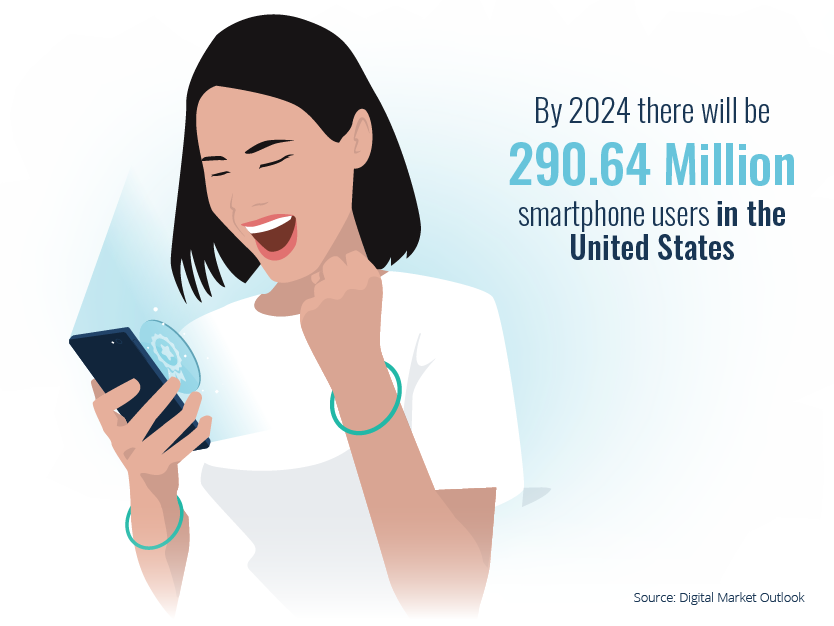
The COVID-19 pandemic has effectively put an end to extensive face-to-face training sessions, lengthy lectures and rigid learning schedules. Learning now occurs at the point of need. As a result, mobile learning has gained a huge amount of traction.
Mobile learning provides learners with easy access to their learning material, any time and any place.
Moreover, content authoring tools are being used to create interactive microlearning material that can be consumed on-the-go. This content is typically easy to digest, engaging and mobile friendly. Game mechanics like Badges, XP and Leaderboards added within the content can also help motivate learners into action.
In the next few years, we can only expect that more companies will adapt a mobile-first design philosophy to appeal to the needs of the modern learner. Before long, the gamification of mobile learning solutions will help increase levels of engagement.
A great example of this is Growth Engineering’s Learning App. This microlearning solution uses gamification to drive better knowledge retention throughout organisations of varying shapes and sizes.
16. Gamification Will Partner With Immersive Technologies (AR, VR, MR)
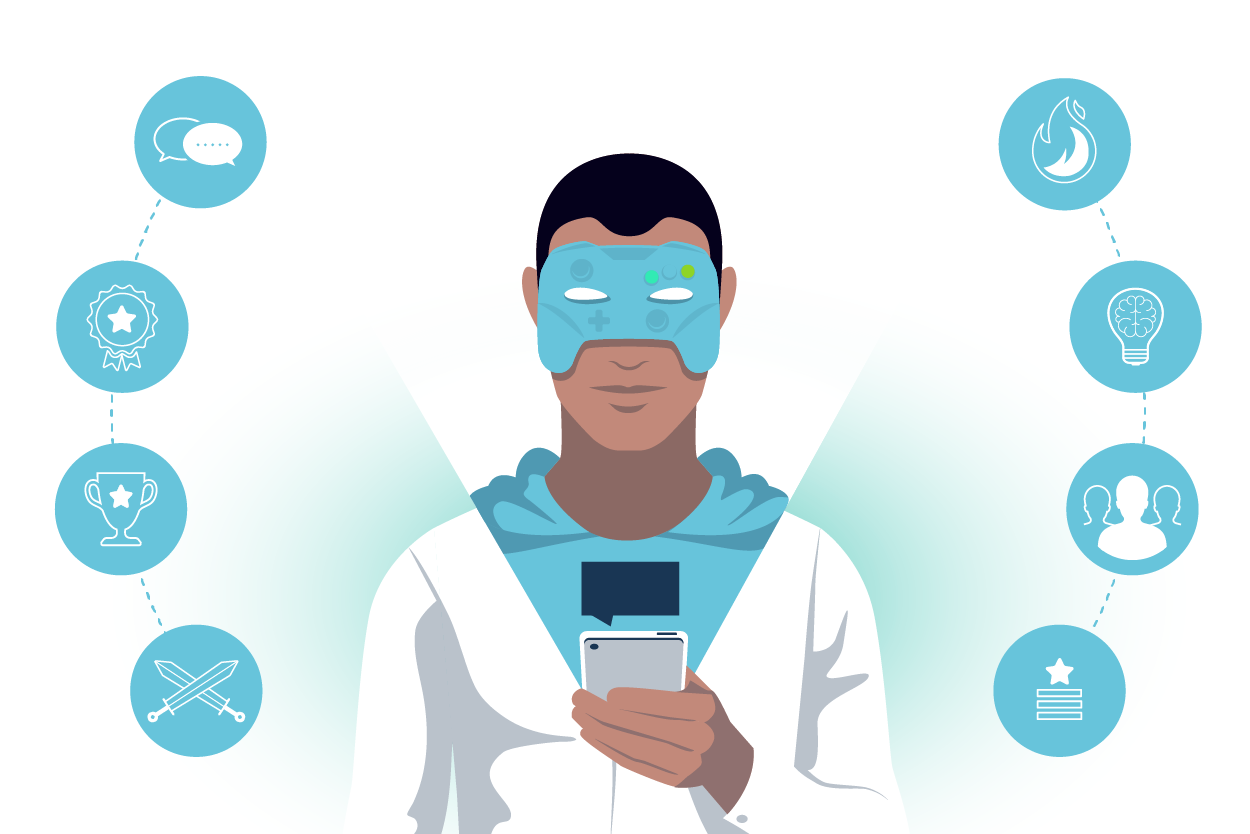 This year will see gamification step up to a new level of accessibility, interactivity and lifestyle integration. This will be facilitated with the use of immersive technologies such as Augmented Reality (AR), Virtual Reality (VR) and Mixed Reality (MR).
This year will see gamification step up to a new level of accessibility, interactivity and lifestyle integration. This will be facilitated with the use of immersive technologies such as Augmented Reality (AR), Virtual Reality (VR) and Mixed Reality (MR).
As these technologies continue to develop, so too will their adoption by a variety of different companies.
Multiple industries are already implementing immersive technologies to conduct onboarding and training activities. Exxon Mobil, for instance, adopted gamified VR to provide safety training for their employees.
In the retail space, global retailer Walmart implemented AR to revolutionise the shopping experience. In 2012, they teamed up with Marvel to create Super Hero AR. This is an augmented reality mobile app designed to help boost in-store traffic and generate more sales. The game invited Avenger fans to visit Walmart stores and unlock super hero powers using the app’s AR technology. Users scored victory points upon collecting all five superhero powers.
As the capacity of immersive technology improves, this will support better gamified experiences. These experiences will fuel engagement in a variety of capacities and could prove to be a game-changer for the gamification market.
17. Artificial Intelligence (AI) Will Integrate With Gamified Solutions
 Here at Growth Engineering we’re excited by the increasing adoption of AI-driven gamified solutions. This is a major growth area. In fact, the AI industry will have a projected value of $190bn by 2025.
Here at Growth Engineering we’re excited by the increasing adoption of AI-driven gamified solutions. This is a major growth area. In fact, the AI industry will have a projected value of $190bn by 2025.
Even at present, 83% of leaders believe AI is a strategic priority for their businesses.
What’s more, there are many companies already using AI and gamification in combination. For instance, Procter & Gamble leveraged AI in their gamified recruitment process. Assessment tests harnessed AI to generate an applicant-centered experience. Exams adjusted dynamically in response to the candidate’s performance. The findings exceeded projections, resulting in a 300% rise in positive employee outcomes.
AI-driven gamified systems are also enabling organisations to tailor better onboarding and training programmes. Data-driven insights and recommendations can be provided in real time by AI engines. Learners are then served with tailor-fit training modules that align with their preferences at any point of their programme.
Creating and administering training material is also becoming increasingly automated with the help of AI. This helps L&D professionals save more time so that they can focus their energy on tasks that really help to move the dial.
All in all, the potential for gamification powered by AI is boundless. As this technology becomes more sophisticated, we can only expect more benefits and possibilities for its use.
18. Internet Of Things (IoT) Will Sync With Gamification Features
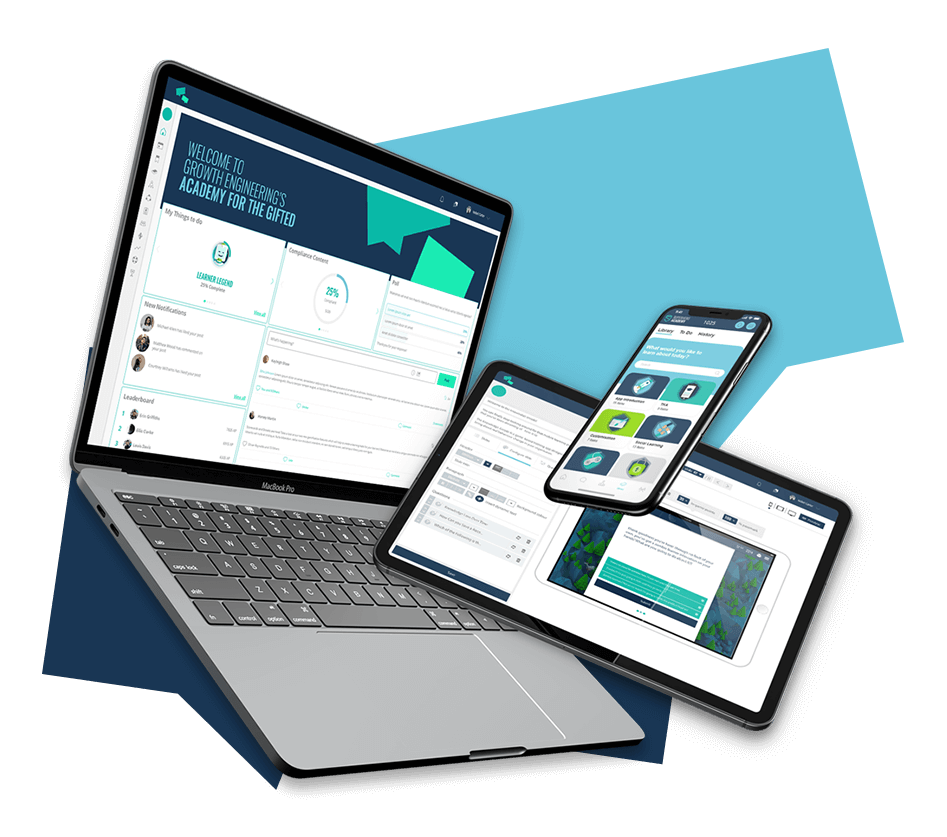 A Gartner study predicts that 30 billion devices will be connected to the Internet by the end of this year. That’s roughly 27.5 billion more than a decade ago! Nielsen also reports that one in six consumers now own a wearable device. Similarly, 35 billion IoT devices will be deployed globally this year, and 75.44 billion by 2025.
A Gartner study predicts that 30 billion devices will be connected to the Internet by the end of this year. That’s roughly 27.5 billion more than a decade ago! Nielsen also reports that one in six consumers now own a wearable device. Similarly, 35 billion IoT devices will be deployed globally this year, and 75.44 billion by 2025.
As such, there is much opportunity for IoT to be able to influence how we live, communicate and interact with others.
In the future, you should expect organisations to integrate IoT devices within their gamified training programmes.
After all, IoT devices provide a deeper scope of data (by incorporating sensory inputs) that can be used to fuel richer recommendations. This could prove to be useful in a variety of contexts. Its integration with gamification could drive further levels of uptake and engagement.
Game mechanics linked with IoT can also provide a more immersive learning experience. For example, Microsoft has created Virtual Stage, a background-matting experiment. The platform connects IoT powered technology and Azure Kinect sensors to create a 3D ‘virtual’ stage for speakers.
There are countless other possibilities for how tech may be adapted for future gamified programmes. The potential is endless.
19. Blockchain Technology Will Ramp Up Digital Transparency & Rewards
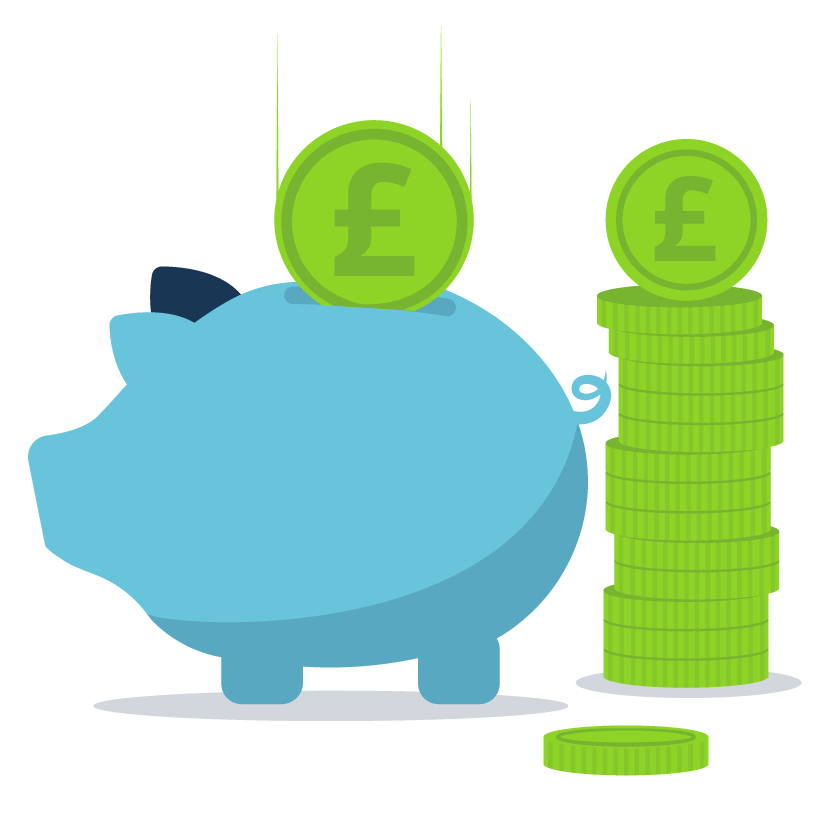 Blockchain technology has empowered and popularised use of cryptocurrencies in recent times.
Blockchain technology has empowered and popularised use of cryptocurrencies in recent times.
In the business world, big companies are using blockchain technology to enhance their loyalty programmes. For example, Singapore Airlines has launched a blockchain-powered campaign for its customers. They could exchange flyer miles earned for digital tokens. More importantly, customers can sleep well knowing that online transactions involving these tokens are secure.
Within gamification, the integration of blockchain technology will add flexibility to game mechanics. For instance, Badges or Experience Points earned could be safely exchanged for cryptocurrencies. In fact, a study shows the benefit of digital incentives powered by blockchain.
The technology can also promote security for digital currencies earned on a gamified LMS or mobile app. For example, recent innovations include blockchain-powered wallets designed to support gamified activities. This enables players to secure their digital rewards within a virtual space.
With this in mind, it’s clear that blockchain has the potential to create a safer and more transparent gamified experience for users across all manner of solutions. This will only help to drive deeper and more meaningful levels of engagement.
Final Words:
From these trends, the picture is clear. We will continue to see the rise of gamification across different sectors. As gamified solutions become more sophisticated, we will also see their impact increase. Large enterprises will continue to innovate existing gamified practices. Smaller companies will get into the game as well, with the support of social media and access to more digital tools.
The rapid growth in smartphone usage will feed a strong demand for gamified mobile solutions. Growing social trends such as remote working and flexible learning practises will also help drive this.
Gamification will also remain a pivotal tool in the workplace to drive employee engagement and business impact. This impact will expand as gamified software evolves and increases in scope. This will result in a new tranche of gamification benefits and use cases that we can explore in the coming years.
So what makes gamification so powerful and effective? This is because it taps into the neuroscience of human motivation and behaviour change. Download our white paper: The Ultimate Guide to Gamification in Online Learning to learn more!

